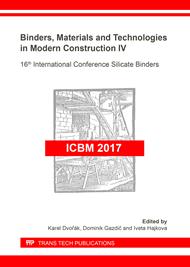[1]
Swapan K. Ghosh, Gulzar Waghoo, Alakesh Kalita, Dinesh Balgude, K. Rajesh Kumar. Chloride-free biodegradable organic acid hydrolyzed zinc silicate coating: Progress in Organic CoatingsVol. 73 (2012), pp.70-75.
DOI: 10.1016/j.porgcoat.2011.09.002
Google Scholar
[2]
L. X. Han, J. Han, F. M. Sun, Y. J. Huo. The Distinctive Charm of Coating-Architecture in the Modern Urban Development:Advanced Materials Research, Vols. 160-162 (2011), pp.880-885.
DOI: 10.4028/www.scientific.net/amr.160-162.880
Google Scholar
[3]
L. Kleerekoper, A. van den Dobbelsteen, E. van den Ham, T. Hordijk, C. Martin. Creating drafts in urban settings through coloured façades: Exploring a new climate adaptation measure based on thermal stratification: Urban Climate Vol. 14 ( 2015), pp.290-300.
DOI: 10.1016/j.uclim.2015.09.002
Google Scholar
[4]
C. Ferrari, A. Libbra, F. M. Cernuschi, L. De Maria, S. Marchionna, M. Barozzi, C. Siligardi, A. Muscio A composite cool colored tile for sloped roofs with high «equivalent» solar reflectance: Energy and BuildingsVol. 114 (2016), pp.221-226.
DOI: 10.1016/j.enbuild.2015.06.062
Google Scholar
[5]
Information http://www.zsm-altair.ru/fotogalereya-0.
Google Scholar
[6]
L. Cheng, S. Feng, R. Li, Z. Lü, G. Li. The provenance study of Chinese ancient architectonical colored glaze by INAA: Applied Radiation and Isotopes Vol. 66 (2008), pp.1873-1875.
DOI: 10.1016/j.apradiso.2008.06.039
Google Scholar
[7]
H. Li, L. Dong, Z. Jiang, X. Yang, Z. Yang. Study on utilization of red brick waste powder in the production of cement-based red decorative plaster for walls:Journal of Cleaner ProductionVol. 133 (2016), pp.1017-1026.
DOI: 10.1016/j.jclepro.2016.05.149
Google Scholar
[8]
H. Brocken, T. G. Nijland. White efflorescence on brick masonry and concrete masonry blocks, with special emphasis on sulfate efflorescence on concrete blocks: Constructionand Building Materials Vol. 18 (2004), pp.315-323.
DOI: 10.1016/j.conbuildmat.2004.02.004
Google Scholar
[9]
G.I. Yakovlev, G.N. Pervushin, О. Kizievich, Yu.N. Ginchitskaya, P.А. Taibakhtina. The influence of salt efflorescence in masonry on the destruction of finishing polymer material. Construction and building materials, 4 (2016) 69-71.
Google Scholar
[10]
Flatt R.J. Salt damage in porous materials: how high supersaturations are generated: Journal Crystal Growth Vol. 242 (2002), pp.435-454.
DOI: 10.1016/s0022-0248(02)01429-x
Google Scholar
[11]
N. M. Sutan, H. Sinin. Efflorescence Phenomenon on Concrete Structures: Advanced Materials Research, Vol. 626 (2013), pp.747-750.
DOI: 10.4028/www.scientific.net/amr.626.747
Google Scholar
[12]
L. Graziani,E. Quagliarini,M. D'Orazio. The role of roughness and porosity on the self-cleaning and anti-biofouling efficiency of TiO2-Cu and TiO2-Ag nanocoatings applied on fired bricks:Construction and Building MaterialsVol. 129 (2016).
DOI: 10.1016/j.conbuildmat.2016.10.111
Google Scholar
[13]
İ. B. Topçu,B. Işıkdağ. Manufacture of high heat conductivity resistant clay bricks containing perlite: Building and Environment Vol. 42 (2007), pp.3540-3546.
DOI: 10.1016/j.buildenv.2006.10.016
Google Scholar
[14]
B. Wanga, Z. Guoa, Y. Hana, T. Zhang. Electromagnetic wave absorbing properties of multi-walled carbon nanotube/cement composites: Constructionand Building Materials Vol. 46 (2013), pp.98-103.
DOI: 10.1016/j.conbuildmat.2013.04.006
Google Scholar
[15]
Shaybadullina A., Politaeva A., Yakovlev G., Pervushin G. Shielding silicate composition of increased durability for repair and rehabilitation: Advanced Materials Research Vol. 1122 (2015), pp.121-126.
DOI: 10.4028/www.scientific.net/amr.1122.121
Google Scholar


